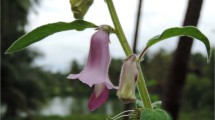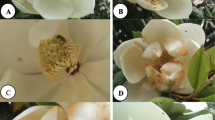Abstract
The intervention of nectar robbers in plant pollination systems will cause some pollinators to modify their foraging behavior to act as secondary robbers, consequently adopting a mixed foraging strategy. The influence of nectar robbing on pollinator behavior may be affected by spatio-temporal difference of robbing intensity, and consequently, may have different effects on the pollination of host plants. However, whether and how the nectar robbing might influence pollinators under different robbing intensity still needs further investigation. In this study, Symphytum officinale was used to detect the effect of nectar robbers on pollinators under different robbing intensity as well as their effects on plant reproductive success. Six robbing levels and three bumblebees with mixed foraging behaviors were used to evaluate the effect of different robbing intensity on pollinator behavior, visitation rate, flower longevity and pollen deposition. Our results indicated that the robbing rate increased gradually with the proportion of robbed flowers, but which did not affect the frequency of legitimate visits. The increase of robbing rate promoted the corolla abscission, and then enhanced the self-pollen deposition, but which had no significant effect on cross-pollen deposition. These results indicate that the overall fitness of S. officinale was improved by combined self and cross-pollination modes when visited by both pollinators and nectar robbers simultaneously. Although nectar robbing is not uncommon, its consequences for pollination in the interaction web have not been well studied. Our results emphasize the significance of indirect impacts in mediating the adaptive outcomes of species interactions.










Similar content being viewed by others
Data availability
The raw data used in the present study are available in this URL: https://datadryad.org/stash/share/aHTdoOJzyxV-EUcV0Q_x2H0U-PuYx8imD169Tzr_Lyk. DOI: doi:https://doi.org/10.5061/dryad.vx0k6djsp.
References
Arizmendi MDC (2001) Multiple ecological interactions: nectar robbers and hummingbirds in a highland forest in Mexico. Can J Zool 79:997–1006. https://doi.org/10.1139/z01-066
Bronstein JL (2001) The exploitation of mutualisms. Ecol Lett 4:277–287. https://doi.org/10.1046/j.1461-0248.2001.00218.x
Chittka L, Gumbert A, Kunze J (1997) Foraging dynamics of bumble bees: correlates of movements within and between plant species. Behav Ecol 8:239–249. https://doi.org/10.1093/beheco/8.3.239
Chittka L, Thomson JD, Waser NM (1999) Flower constancy, insect psychology, and plant evolution. Naturwissenschaften 86:361–377. https://doi.org/10.1007/s001140050636
Dyer WT (1877) The effects of cross and self-fertilisation in the vegetable kingdom. Nature 15:329–332. https://doi.org/10.1038/015329a0
Fumero-Cabán JJ, Meléndez‐Ackerman EJ (2007) Relative pollination effectiveness of floral visitors of Pitcairnia angustifolia (Bromeliaceae). Am J Bot 94:419–424. https://doi.org/10.3732/ajb.94.3.419
Gonzalez-Gomez PL, Valdivia CE (2005) Direct and indirect effects of nectar robbing on the pollinating behavior of Patagona gigas (Trochilidae). Biotropica 37:693–696. https://doi.org/10.1111/j.1744-7429.2005.00088.x
Grüter C, Moore H, Firmin N, Helanterä H, Ratnieks FL (2011) Flower constancy in honey bee workers (Apis mellifera) depends on ecologically realistic rewards. J Exp Biol 214:1397–1402. https://doi.org/10.1242/jeb.050583
Guitian J, Sánchez JM, Guitian P (1994) Pollination ecology of Petrocoptis Grandiflora Rothm (Caryophyllaceae): a species endemic to the north-west part of the Iberian Peninsula. Bot J Linn Soc 115:19–27. https://doi.org/10.1111/j.1095-8339.1994.tb01764.x
Hou QZ, Ehmet N, Chen DW, Wang TH, Xu YF, Ma J, Sun K (2021) Corolla abscission triggered by nectar robbers positively affects reproduction by enhancing self-pollination in Symphytum officinale (Boraginaceae). Biology 10:903. https://doi.org/10.3390/biology10090903
Inouye DW (1980a) The effect of proboscis and corolla tube lengths on patterns and rates of flower visitation by bumblebees. Oecologia 45:197–201. https://doi.org/10.1007/BF00346460
Inouye DW (1983) The biology of nectaries: the ecology of nectar robbing. Columbia University, New York, pp 153–173
Irwin RE, Brody AK (1998) Nectar robbing in Ipomopsis aggregata: effects on pollinator behavior and plant fitness. Oecologia 116:519–527. https://doi.org/10.1007/s004420050617
Irwin RE, Maloof JE (2002) Variation in nectar robbing over time, space, and species. Oecologia 133:525–533. https://doi.org/10.1007/s00442-002-1060-z
Irwin RE, Brody AK, Waser NM (2001) The impact of floral larceny on individuals, populations, and communities. Oecologia 129:161–168. https://doi.org/10.1007/s004420100739
Irwin RE, Bronstein JL, Manson JS, Richardson L (2010) Nectar robbing: ecological and evolutionary perspectives. Ann Rev Ecol Evol Syst 41:271–292. https://doi.org/10.1146/annurev.ecolsys.110308.120330
Klinkhamer PGL, de Jong TJ (1993) Attractiveness to pollinators: a plant’s dilemma. Oikos 66:180–184. https://doi.org/10.2307/3545212
Lara C, Ornelas J (2001) Preferential nectar robbing of flowers with long corollas: experimental studies of two hummingbird species visiting three plant species. Oecologia 128:263–273. https://doi.org/10.1007/s004420100640
Laverty TM (1994) Bumble bee learning and flower morphology. Anim Behav 47:531–545. https://doi.org/10.1006/anbe.1994.1077
Lewis AC (1986) Memory constraints and flower choice in Pieris rapae. Science 232:863–865. https://doi.org/10.1126/science.232.4752.863
Maloof JE (2001) The effects of a bumble bee nectar robber on plant reproductive success and pollinator behavior. Am J Bot 88:1960–1965. https://doi.org/10.2307/3558423
Maruyama PK, Vizentin-Bugoni J, Dalsgaard B, Sazima I, Sazima M (2015) Nectar robbery by a hermit hummingbird: association to floral phenotype and its influence on flowers and network structure. Oecologia 178:783–793. https://doi.org/10.1007/s00442-015-3275-9
McNaughton SJ, Banyikwa FF, McNaughton MM (1997) Promotion of the cycling of diet-enhancing nutrients by African grazers. Science 278:1798–1800. https://doi.org/10.1126/science.278.5344.179
Morris WF (1996) Mutualism denied? Nectar-robbing bumble bees do not reduce female or male success of bluebells. Ecology 77:1451–1462. https://doi.org/10.2307/2265542
Nagano Y, Yokoi T (2022) Honeybees with extensive foraging experience rob nectar more frequently. Sci Nat 109: 11. https://doi.org/10.1007/s00114-021-01781-7
Pyke GH (1982) Local geographic distributions of bumblebees near Crested Butte, Colorado: competition and community structure. Ecology 63:555–573. https://doi.org/10.1603/EN11284
Pyke GH, Inouye DW, Thomson JD (2012) Local geographic distributions of bumble bees near Crested Butte, Colorado: competition and community structure revisited. Environ Entom 41:1332–1349. https://doi.org/10.1603/EN11284
Real LA (1991) Animal choice behavior and the evolution of cognitive architecture. Science 253:980–986. https://doi.org/10.1006/anbe.2000.1606
Richardson SC (2004) Are nectar-robbers mutualists or antagonists? Oecologia 139:246–254. https://doi.org/10.2307/177331
Richman SK, Irwin RE, Bronstein JL (2017) Foraging strategy predicts foraging economy in a facultative secondary nectar robber. Oikos 126:1250–1257. https://doi.org/10.1111/oik.04229
Rodriguez-Girones MA, Santamaría L (2007) Resource competition, character displacement, and the evolution of deep corolla tubes. Am Nat 170:455–464. https://doi.org/10.1086/520121
Rojas-Nossa SV, Sánchez JM, Navarro L (2016) Nectar robbing: a common phenomenon mainly determined by accessibility constraints, nectar volume and density of energy rewards. Oikos 125:1044–1055. https://doi.org/10.1111/oik.02685
Singh VK, Barman C, Tandon R (2014) Nectar robbing positively influences the reproductive success of Tecomella Undulata (Bignoniaceae). PLoS ONE 9:e102607. https://doi.org/10.1371/journal.pone.0102607
Stout JC, Allen JA, Goulson D (2000) Nectar robbing, forager efficiency and seed set: bumblebees foraging on the self incompatible plant Linaria vulgaris (Scrophulariaceae). Acta Oecol 21:277–283. https://doi.org/10.1016/S1146-609X(00)01085-7
Thompson J (2009) The coevolutionary process. University of Chicago, Chicago, p 404
Varma S, Sinu P (2019) Nectar robbing in bellflower (Sesamum radiatum) benefited pollinators but unaffected maternal function of plant reproduction. Sci Rep 9:8357. https://doi.org/10.1038/s41598-019-44741-y
Wang Y, Wu H, Wang S (2015) Invasibility of nectar robbers in pollination-mutualisms. Appl Math Comput 250:908–919. https://doi.org/10.1016/j.amc.2014.11.027
Ye ZM, Jin XF, Wang QF, Yang CF, Inouye DW (2017) Nectar replenishment maintains the neutral effects of nectar robbing on female reproductive success of Salvia przewalskii (Lamiaceae), a plant pollinated and robbed by bumble bees. Ann Bot 119:1053–1059. https://doi.org/10.1093/aob/mcw285
Ye ZM, Jin XF, Inouye DW, Wang QF, Yang CF (2018) Variation in composition of two bumble bee species across communities affects nectar robbing but maintains pollinator visitation rate to an alpine plant, Salvia przewalskii. Ecol Entomol 43:363–370. https://doi.org/10.1111/een.12509
Zhang YW, Zhao JM, Inouye DW (2014) Nectar thieves influence reproductive fitness by altering behaviour of nectar robbers and legitimate pollinators in Corydalis Ambigua (Fumariaceae). J Ecol 102:229–237. https://doi.org/10.1111/1365-2745.12166
Zimmerman M, Cook S (1985) Pollinator foraging, experimental nectar-robbing and plant fitness in Impatiens capensis. Am Midl Nat 113:84–91
Acknowledgements
This research was funded by the National Natural Science Foundation of China, grant numbers 32260054 and 31860051. Attached file with confirm the changes and comments.
Author information
Authors and Affiliations
Contributions
Conceptualization, Q.Z.H. and N.E.; software, T.H.W and Q.-Z.H.; writing—original draft preparation, N.E. and T.H.W.; writing—review and editing, N.E, T.H.W, Q.Z.H.; supervision, K.S.; methodology, Y.P.Z and X.Z.
Corresponding author
Ethics declarations
Conflict of interest
The authors declare no conflict of interest.
Additional information
Publisher’s Note
Springer Nature remains neutral with regard to jurisdictional claims in published maps and institutional affiliations.
Rights and permissions
Springer Nature or its licensor (e.g. a society or other partner) holds exclusive rights to this article under a publishing agreement with the author(s) or other rightsholder(s); author self-archiving of the accepted manuscript version of this article is solely governed by the terms of such publishing agreement and applicable law.
About this article
Cite this article
Ehmet, N., Wang, TH., Zhang, YP. et al. Effect of robbing intensity on reproductive success of Symphytum officinale (Boraginaceae). J Plant Res (2024). https://doi.org/10.1007/s10265-024-01536-1
Received:
Accepted:
Published:
DOI: https://doi.org/10.1007/s10265-024-01536-1




